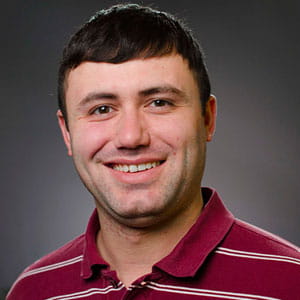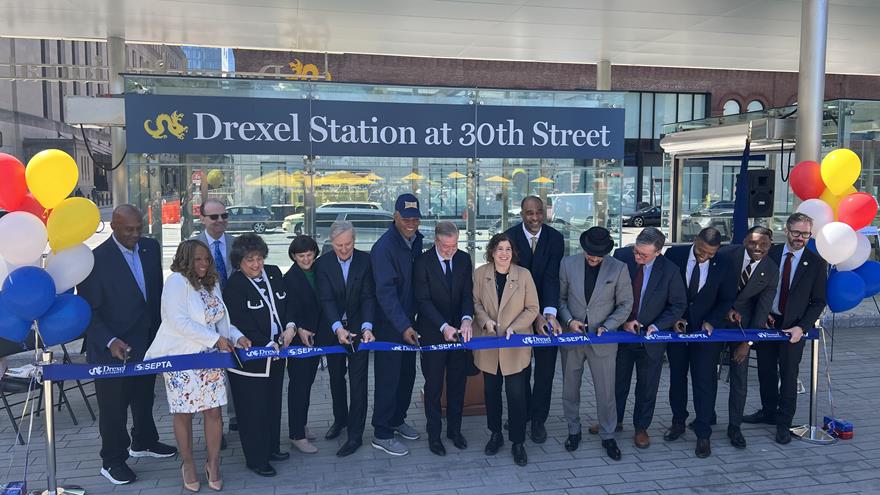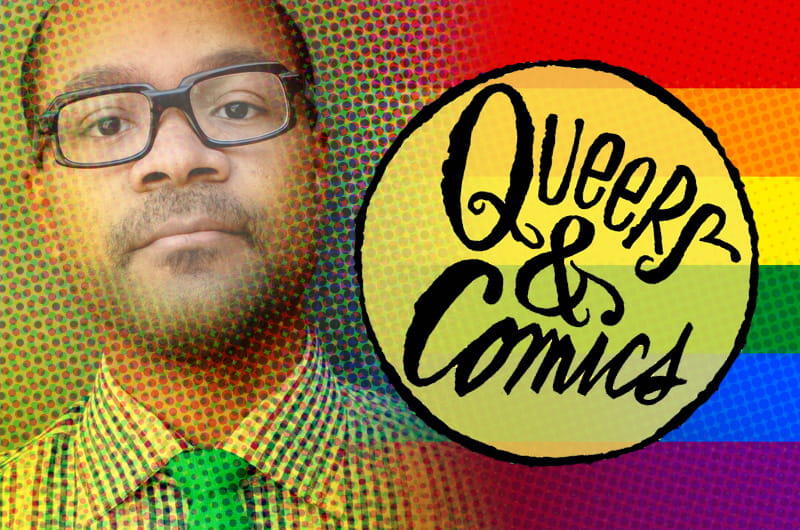Drexel Professor Behind International LGBT Comics Conference
 By Frank Otto
By Frank Otto

- Ribbon-Cutting Ceremony Marks Official Unveiling of Drexel Station at 30th Street
- Drexel’s Pearlstein Gallery Offers Spring Exhibitions Centered on the Healing Properties of Art and Creative Works
- Express Your Thoughts About Climate Change in the Anthems for the Anthropocene Contest
- 40 Years Ago, Drexel Made Computer — and Apple — History

Drexel Pride Month began Friday. It is a time to recognize the impact the lesbian, gay, bisexual and transgender communities have had on the United States and the world both historically and culturally.
One area where the LGBT community has only recently begun to see mainstream recognition and support is the world of comics. Now a juggernaut of the entertainment industry, the comic industry has largely ignored LGBT characters and authors/artists.
Drexel assistant professor of English André Carrington and artist Jen Camper teamed up to organize an international conference featuring the creative minds behind the LGBT comics that have found prominence and recognize this underrepresented population.
That conference, Queers & Comics, will be held this weekend, May 7–8 in New York City.
Carrington took time to talk to DrexelNow about the conference.
Q: First, who is your favorite comic book character?
A: Storm from the Marvel X-Men comics is a longtime favorite; she’s probably the most recognizable black comic book character and maybe the second-most recognizable woman depicted in comics, after Wonder Woman. She’s been featured in great stories for 40 years. I have a figurine of her in my office.
Q: Minority characters are traditionally pretty underrepresented in comics and LGBT characters are featured even less. Do you think strides are being made? Do you think this conference will help?
A: Mainstream comic book companies have been slow to employ and to represent people of color and LGBT people, and we see the same patterns in publishing and other media industries.
By working independently and creating outlets of their own, however, a really diverse group of LGBT comics artists has shown the value of creativity for people of all backgrounds. The conference will commemorate that work, including a reunion of contributors to the groundbreaking “Gay Comix” series that started in 1980.
One way the conference may have a wider impact is by showcasing the contributions of people of color and transgender writers and artists, as well as artists from outside the United States who can shed light on how representation plays out differently in various languages and reading publics. As I teach in my course on comics and graphic novels, underground and alternative comix, as well as webcomics, have much more diverse topics than the big companies represent, and the medium of comics fits in with literature and the publishing industry very differently in France, Belgium and Japan, as opposed to North America.
Q: Comic conventions have a reputation for featuring “cosplay” (attendees dressing like their favorite characters) and bleeding into pop culture genres like film and gaming that may not exactly be related to comics. How will this conference be similar and how will it be different?
A: I hope there will be some cosplay, but this isn’t a convention. With a packed schedule of panel discussions, the conference will provide a venue for artists and scholars to have conversations. At conventions, artists have to work the whole time — they have to sell their books and promote the companies who distribute their work to make a living.
While we all enjoy a range of media and creative forms along with comics and cartoon art, Queers & Comics is providing a platform for creators to share stories and images that represent their medium in all its forms, from self-published books to zines to webcomics to political cartoons. That will make it a unique opportunity for scholars, as well.
Q: Is there a certain topic or theme you are particularly excited for?
A: We have been so bogged down in details for months that it’s hard to say. Once we posted the schedule on the website, co-organizer Jen Camper and I stepped back and realized this is an unprecedented gathering of talent.
But I am most excited, personally, to have this opportunity to host an artist whose career has inspired me since I was a teenager: Ivan Velez Jr.
Ivan was one of the principal creators involved in Milestone Media, a black-owned publisher that introduced some of the first and most exciting images of queer people of color in comic books in the 1990s. Velez will be convening a conversation with Japanese gay manga artist Gengoroh Tagame at the event, along with the translator and editor who have published Tagame’s work in English.
Q: Is this conference something you hope becomes an annual event? What do you hope it accomplishes?
A: There has been some discussion of having another conference in two years on the West Coast, and I would like to help make that happen. In addition to documenting the legacy of lesbian, bisexual, transgender and gay cartoonists, I hope it will help bring emerging voices in this art form to the attention of readers, including academics.
Ultimately, I also hope this conference helps the organization I work with, CLAGS: The Center for LGBTQ Studies, demonstrate how creativity and research complement each other when it comes to producing knowledge about areas of culture and society that are otherwise left on the margins. My principal collaborator, Jen Camper, who came up with the idea for the conference, is a cartoonist, and I’d like to think that the event reflects her priorities as a working artist as well as my expertise as a scholar who reads and writes about comics as literature.
Q: Final, traditional comic question — Who would win in a fight: DC’s Hawkman or Marvel’s Hawkeye?
A: Neither. I think they would hug it out.
In This Article
Contact
Drexel News is produced by
University Marketing and Communications.